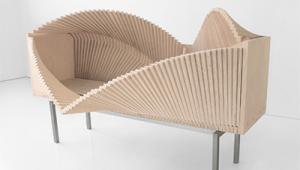Matthew Burt Furniture
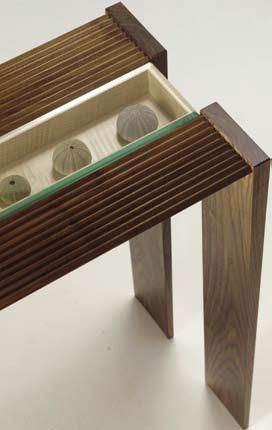
“Another speculative piece, I made this in American walnut and English ash after being inspired by seeing the remains of earthquake damage in the Ionian Islands. The top is ‘rent asunder’ to provide a display space, in this case filled with spent urchin shells – from the very seas that surround the islands. The glass that covers the display space is set at the same height as the peaks of the rippled V-grooves, thus providing a stable surface for placing display items.”
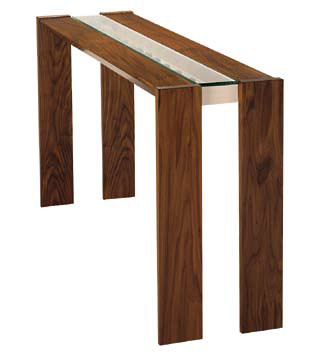

“The elm’s towering glory was a constant companion in my youth. Dutch elm disease nearly wiped them out, and they’re dying out in Scotland now, so I felt obliged to memorialise their sad disappearance from our landscape with a series of pieces. Elm has a bad reputation, because it’s tough, difficult to work, blunts tools, and misbehaves a lot during seasoning. But I love its rugged character, and couldn’t resist the challenge.
“The Canti-Two Hallway Table was originally designed and speculatively made as an entrance or hallway piece, directing and welcoming you into the home. Its surface is diagonally V-grooved to enhance it and to demonstrate that solid timber is beautiful all the way through. I also tried to impart a jewel-like quality, so as to heighten people’s perception of this precious material. The design won the Master’s Gold Award from the Worshipful Company of Furniture Makers.
“The Finback Chairs are almost entirely handmade and require a sophisticated level of skill to sculpt the sensual curves of the body. The awkward, cussed elm I used certainly didn’t give up its charm without a fight! Two of these chairs were bought for the Permanent Collection at the Fitzwilliam Museum in Cambridge 2005.”


“Made in European and American walnut, I wanted the top of this piece to show the journey of life that a tree undergoes. I see wood as recycled sunshine and rainwater, and I believe it’s a gift. We furnituremakers are a long way from getting close to the amazing degree of natural design in a tree; I want to create pieces that demonstrate that intrinsic beauty.
“The table is made from 3mm thick workshopsawn veneers, taken from 16 consecutive cuts through a tree. The cuts were then laid out in a radiating pattern, showing off its natural beauty while exposing the fascinating way in which it grows. When I displayed it at the Origin show [at Somerset House in London], one onlooker remarked that, “it was a credit to the tree”. I’m not so sure, but I’m definitely proud of the piece.”

“Another table from European and American walnut, there’s more to it than meets the eye. The client required a table that usually seats eight, but could be expanded to seat sixteen when required. I came up with a plan to avoid the complicated solutions you usually get with expanding circular tables. I created a separate chest in which eight crescents are stored, so that when expanded, these are added to the table, supported on eight pull-out rails. The radiating pattern of sixteen mirror-matched segments on the top of the table continues out into the added crescents to provide a spectacular pattern at both sizes.”
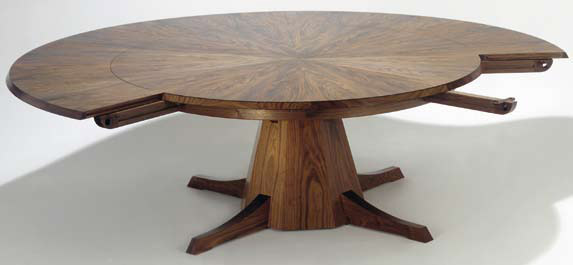

“I made this set in European cherry. It was originally designed and made to help fund my daughter’s MA – I told you we had debt problems! It’s part of an expansive cantilevered series, and like the Canti-Two Hallway Table above, I explored the visual danger of balance.”
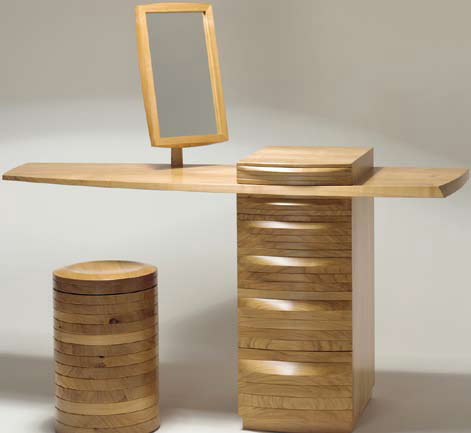

“It might look like a simple object, but this piece is perhaps my most successful design, and probably my favourite. It’s made from oak and oak-faced ply, and came about for a couple of reasons. Back in the late Eighties, I was going to a lot of shows and I once noticed a furnituremaker standing gloomily by some antique furniture. Next to him was a woman who made cardigans, and she was making sale after sale, pocketing buckets of money. I wanted to sell something people could buy spontaneously too, and so the key cabinet was born. Why a key cabinet? Well, my wife and I always had a different idea of where the keys should be kept, so I knew that if I made something stunning enough we could come to a mutual agreement!
“For the design, I came up with an idea that joins components in a novel manner, using a series of grooves and wooden hinges. It’s marketable, saleable and easy to construct in numbers, while still being aesthetically pleasing and functional.”
- Log in or register to post comments


